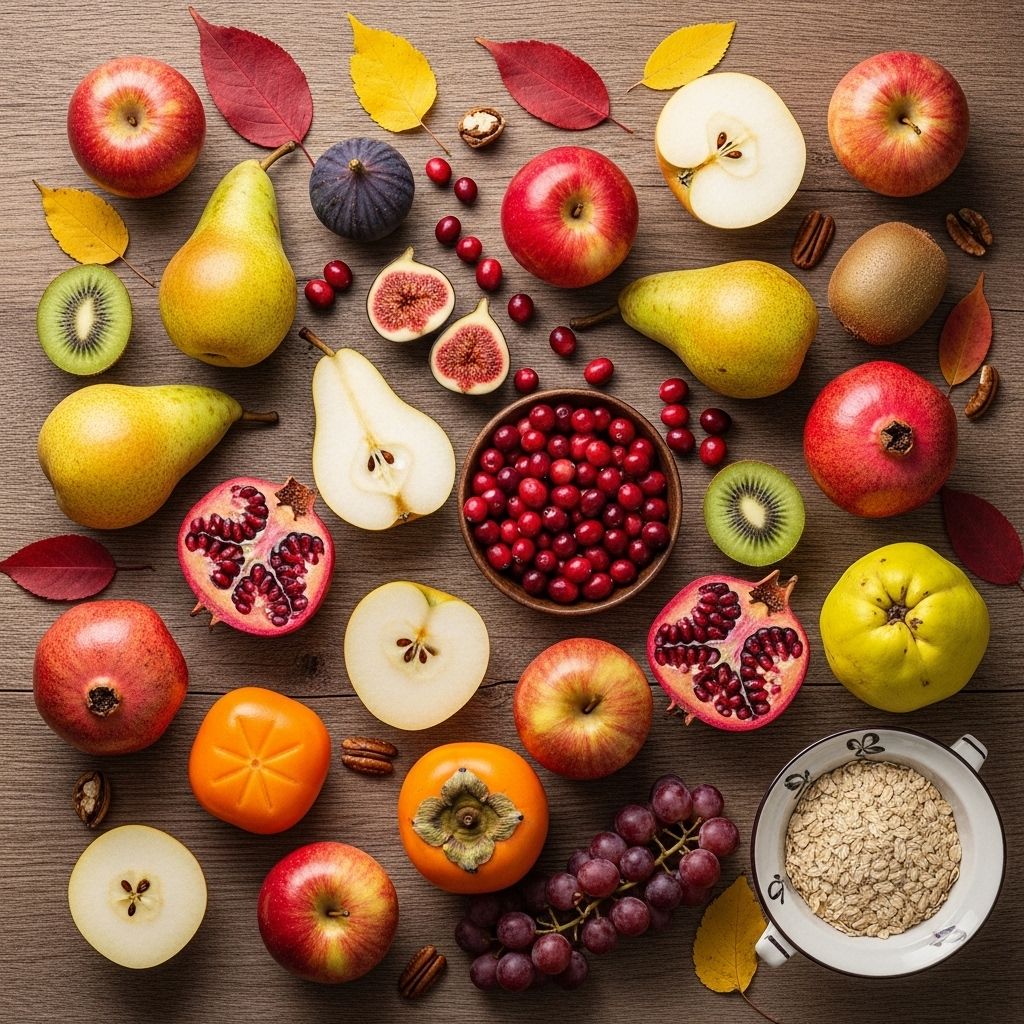15 Best Fall Fruits and How to Enjoy Them This Season
Enjoy the season’s harvest with simple, flavor-packed creations for every occasion.

The bounty of fall extends far beyond pumpkin patches and apple orchards. Autumn delivers an incredible array of fruits—each with its own distinctive flavor, peak ripeness, and culinary possibilities. From versatile apples to jewel-toned pomegranates and luscious figs, these seasonal stars offer nourishing sweetness and inspiration for cozy kitchen creations. This comprehensive guide covers the 15 best fall fruits, expert buying and storage advice, and delicious ways to put them to use all season long.
1. Apples
Peak Season: Early September through late fall
Apples are synonymous with crisp autumn air. With hundreds of varieties—ranging from sweet to tart—there’s an apple for every palate:
- How to Choose: Firm, unblemished skin with vibrant color. Popular fall varieties include Honeycrisp, Fuji, Gala, and Granny Smith.
- Cooking Ideas:
- Classic apple pie or apple crumbles
- Homemade applesauce
- Chunky apple-cranberry stuffing for holiday roasts
- Tip: Visit a pick-your-own orchard for the freshest fruit and family fun.
2. Pears
Peak Season: Late summer through October
Pears ripen after harvest, making them easy to enjoy at home once they’re just right.
- Varieties: Bartlett, Bosc, Anjou, Comice, Seckel
- Flavor: Ranges from delicately sweet to robust and spicy.
- Serving Ideas:
- Pear crisp with vanilla ice cream—for a change from apple desserts
- Sliced in ham, cheese, and pear paninis
- Arranged fresh on charcuterie boards
- Storage: Let firm pears ripen at room temperature, then refrigerate.
3. Pomegranate
Peak Season: Mid to late autumn
Pomegranates capture fall’s richness inside their tough skin, bursting with juicy, tart, gem-like seeds called arils.
- Nutrition: High in antioxidants, vitamin C, and fiber.
- How to Use:
- Sprinkle seeds over salads or roasted vegetables (try with Brussels sprouts)
- In festive drinks like pomegranate margaritas
- As a colorful topping for yogurt parfaits
4. Figs
Peak Season: Early fall
- Flavor: Soft, jammy, honey-sweet flesh in each bite
- How to Eat:
- Enjoy fresh with cheese (think goat cheese or blue cheese)
- Stuff halved figs and wrap in prosciutto, then roast
- Add to autumn salads or bake into rustic tarts
- Storage: Very perishable—eat within a day or two of purchase.
5. Cranberries
Peak Season: October through December
- Known for their tart, astringent flavor
- Popular Uses:
- Traditional cranberry sauce for holiday tables
- Homemade jams and relishes
- Baked into muffins, cakes, or scones
- Nutrition: Packed with antioxidants and vitamin C.
6. Grapes
Peak Season: Late summer through October
- Varieties: Concord, Red Globe, Thompson Seedless, Black Corinth
- Enjoy:
- As a snack or dessert addition (try freezing grapes for a frosty treat!)
- Roasted and served alongside meats or with cheese plates
- Tip: Use juicy fall grapes to make homemade grape jelly or jam.
7. Persimmons
Peak Season: October through December
- Types: Fuyu (crunchy and sweet like an apple) vs. Hachiya (soft, lush, and great for baking)
- How to Use:
- Eat Fuyu persimmons raw, slices in salads or paired with mild cheeses
- Bake Hachiya persimmons into puddings, breads, and cakes
- Tip: Only eat Hachiya persimmons when fully soft—they are astringent until ripe.
8. Plums
Peak Season: Late summer into early fall
- Flavor: Ranges from tart to sweet, depending on variety (Black, Red, or Italian Prune plums).
- Ideas:
- Enjoy fresh as a juicy snack
- Bake into crisps, cobblers, or German-style plum cakes
- Simmer into jams and preserves
9. Quince
Peak Season: September to November
- Note: Typically too tough and tart to eat raw—best cooked.
- How to Enjoy:
- Simmer in sugar syrup for poached quince
- In jams and membrillo (Spanish quince paste for cheese boards)
- Baked into tarts and crisps
10. Kiwi
Peak Season: Fall through late winter
- Flavor: Tart, tropical, and juicy
- Tip: Try golden kiwi for a sweeter, less acidic twist
- Serving Ideas:
- Scoop with a spoon and eat straight or slice into fruit salads
- Add to smoothies for vitamin C boost
11. Concord Grapes
Peak Season: September through October
- Flavor: Richly sweet and fragrant, used in classic grape jelly
- How to Enjoy:
- Homemade grape pies or tarts
- Roasted and served on toast with ricotta
- Tip: Remove seeds before adding to recipes for smooth texture.
12. Dates
Peak Season: Fall and early winter
- Varieties: Medjool (plump, soft) and Deglet Noor (drier, firmer)
- Enjoy:
- On cheese boards for natural sweetness
- Stuff with cheese or nuts, wrap in bacon and roast for appetizers
- As a natural sweetener in baking or smoothies
13. Guava
Peak Season: Early fall through winter (in warm climates and specialty markets)
- Flavor: Floral, tropical, and subtly sweet
- How to Enjoy:
- Eat fresh (remove seeds and skin as desired)
- Mash into guava jelly or puree for cocktails
- Bake into cakes and pastries
14. Asian Pears
Peak Season: Late August through November
- Texture: Crisp and incredibly juicy, like a cross between an apple and a pear
- Use:
- Snack on raw or toss in salads for crunch
- Pair with sharp cheeses on appetizer trays
- Storage: Keep in the fridge for several weeks.
15. Concord Grapes
Peak Season: September to October
- Attributes: Intensely aromatic and flavorful—excellent for jams, jellies, and fresh eating (watch for seeds!)
Fall Fruit FAQ
How do I store fall fruits to keep them fresh longest?
Most fall fruits do best in a cool, dry place. Apples, pears, and Asian pears keep well refrigerated. Grapes, berries, and figs should always be kept cold and eaten quickly. Let pears ripen at room temperature, then move to the fridge.
What are the healthiest fall fruits?
Cranberries, pomegranates, and apples top the list for antioxidants and fiber. Figs and persimmons offer potassium and vitamins. Eating a variety ensures a range of nutrients.
Are fall fruits good for baking?
Absolutely! Apples, pears, plums, and even cranberries are favorites for pies, crisps, muffins, and cakes. Try substituting or combining different fruits in recipes for new flavors and textures.
Can I enjoy fall fruits in savory dishes?
Yes! Pears and apples brighten up salads, stuffings, and sandwiches. Pomegranate and figs add festive flair to roasted meats and vegetables. Use grapes or raisins in autumn braises and rice dishes for a sweet-savory twist.
Where can I pick my own fall fruits?
Many local orchards offer apple and sometimes pear picking in September and October. Check your area for family-run farms—it’s a fun way to sample different varieties at their freshest and stock up for snacks and cooking.
Fall Fruit Recipe Ideas
- Apple Dumplings: Wrap tart apple wedges in pastry with sweet spices. Bake until caramelized—serve warm with vanilla ice cream.
- Pear Crisp: Toss sliced pears with sugar and cover with a buttery oat topping. Bake for a rustic, crowd-pleasing dessert.
- Pomegranate Brussels Sprouts: Toss sautéed Brussels sprouts with fresh pomegranate arils for a sweet, tart, and crunchy finish.
- Plum Cake: Simple yeasted or sponge-style cake crowned with juicy, purple-hued plums—delightful with afternoon tea.
- Date and Nut Bread: Moist quick bread studded with sweet dates and walnuts makes a perfect fall breakfast.
How to Choose the Freshest Fall Fruit
| Fruit | What to Look For |
|---|---|
| Apple | Firm, shiny skin; no bruises |
| Pear | Just barely soft near stem; fragrant aroma |
| Fig | Plump and tender, but not splitting |
| Pomegranate | Heavy for its size, deep red skin |
| Grape | Plump, firmly attached to stems |
| Persimmon | Glossy skin, deep color; soft (if Hachiya) |
| Quince | Bright yellow, fragrant peel; avoid bruises |
Tips for Using Fall Fruits in Everyday Cooking
- Pair sweet fall fruits with savory herbs: Apples with sage, pears with rosemary, plums with thyme.
- Add pomegranate arils: For bright pops of color and flavor atop roasted veggies and salads.
- Make it cozy: Try warm fruit crisps, compotes, and crumbles as comforting desserts.
- Preserve the harvest: Can your own jams, sauces, and chutneys to enjoy fall flavors past the season.
How to Get Kids to Eat More Fall Fruit
- Serve apples and pears sliced with nut butter dips for snacks
- Layer fruit and yogurt parfaits with a sprinkle of granola
- Bake fruit muffins or breakfast bars together
- Make fun fruit skewers using grapes, figs, and apple pieces
Frequently Asked Questions (FAQs) About Fall Fruits
Q: What is the easiest fall fruit to grow at home?
A: Apples, pears, and figs can thrive in home gardens given the right variety and care.
Q: What’s the best fall fruit for people with a sweet tooth?
A: Dates and fresh figs are naturally candy-sweet and rich in nutrients.
Q: Are there any rare fall fruits to look out for?
A: Quince and pawpaw are unusual but worth seeking out at specialty markets or farmers’ stands.
Q: Which fall fruit lasts longest in storage?
A: Apples and Asian pears can last for months when refrigerated and kept dry.
Q: Can you freeze fall fruits?
A: Most can be frozen after chopping and spreading on a tray, especially apples, pears, cranberries, and plums.
Celebrate Autumn with Nature’s Sweetest Harvest
From orchard outings to holiday feasts, fall fruit brings color, cheer, and wholesome goodness to every table. Explore local markets for the freshest finds, experiment with simple and seasonal recipes, and savor the flavors that make autumn unforgettable!
References
- https://www.thepioneerwoman.com/food-cooking/cooking-tips-tutorials/g44131843/fall-fruits/
- https://www.thepioneerwoman.com/home-lifestyle/g65984291/best-apple-picking-near-me/
- https://www.thepioneerwoman.com/food-cooking/meals-menus/g61880633/ree-drummond-favorite-fall-recipes/
- https://www.goodmorningamerica.com/shop/story/ree-drummond-guide-fall-decor-cooking-hacks-113153354
- https://www.aol.com/ree-drummonds-top-10-favorite-110000603.html
Read full bio of Sneha Tete












